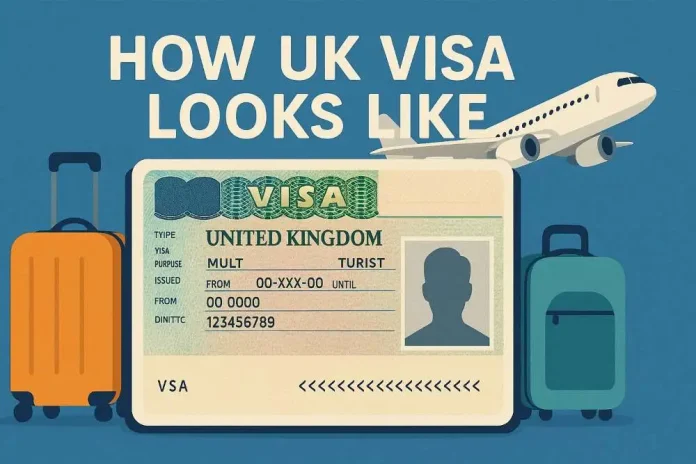The UK visa is an essential document for those planning to enter the United Kingdom for purposes such as tourism, business, work, or study. Understanding the appearance, design, and features of a UK visa is crucial for applicants, especially when it comes to verifying authenticity and knowing what to expect during the application process. In this article, we will explore how a UK visa looks like, the various types of UK visas, and the important information included on the visa that applicants should be aware of.
Types of UK Visas
The first step in understanding the design of a UK visa is recognizing the different types available. Each visa serves a distinct purpose, and as such, they may have slightly different designs or features. The main types of UK visas include:
- UK Tourist Visa (Standard Visitor Visa): This visa is issued for short stays of up to six months for leisure, tourism, or visiting family members.
- UK Student Visa: Students wishing to study at a UK university or college apply for a student visa, which is valid for the duration of the course.
- UK Work Visa: Individuals coming to the UK for employment purposes apply for a work visa, such as a Tier 2 (General) visa for skilled workers.
- UK Transit Visa: For individuals passing through the UK to a third country, a transit visa is required.
- UK Family Visa: This visa allows family members of individuals in the UK to join them for a specific period.
- UK Business Visa: For those coming to the UK for business purposes such as meetings or conferences.
The visual features of each of these visa types might look the same but will vary slightly depending on the specifics of the visa holder’s purpose for travel.
The Design and Appearance of a UK Visa
A UK visa typically comes in the form of a sticker or vignette affixed to a passport. Here’s what you can expect when you receive your UK visa:
Key Visual Elements on a UK Visa
- Visa Sticker Placement: The visa is typically placed in a page of the passport, often on the first page, with a clear and prominent display of the visa label.
- Visa Sticker Colors: While the color may vary slightly, UK visas often have a distinct blue, purple, or green tint. For example, the Student visa vignette has a purple hue, while other types like the Visitor visa may have a greenish shade.
- Personal Information: The visa will display the applicant’s name, date of birth, passport number, nationality, and gender. This section is printed in both English and the applicant’s native language.
- Visa Type and Details: The type of visa (e.g., Visitor Visa, Student Visa) will be indicated, along with the visa’s start and end dates, specifying the validity of the visa.
- Duration of Stay: This is indicated by the “Date of Arrival” and “Date of Expiry” or “Duration of Stay,” which helps you understand the period within which you are permitted to enter and remain in the UK.
- Visa Conditions and Restrictions: UK visas also include conditions such as whether work is allowed, whether the visa holder is restricted to certain activities, or whether the visa holder must register with the police. These details will be noted clearly in the visa.
- Biometric Details: A digital scan of the applicant’s biometric details (such as fingerprints) is typically stored in the UK visa system. Some visas may have a biometric chip embedded in the document.
- Visa Fee Information: The visa fee amount is listed clearly on the visa application form. UK visa fees vary based on the type of visa, and it’s important to know how much you’ll need to pay for your application.
- UK Visa Logo: The UK visa typically displays the official logo, which includes the Union Jack and other official symbols, ensuring authenticity.
What’s Missing from the UK Visa Sticker?
It’s important to note that while the visa sticker contains most of the essential information, it does not contain detailed personal history or reasons for application. Any detailed information regarding the visa holder’s eligibility or reasons for applying would have been reviewed during the UK visa application process.
UK Visa Application Process and Requirements
For international students, workers, and tourists, understanding how to apply for a UK visa is critical. Here’s a quick overview of the UK visa application process:
- Choose the Right Visa Type: Depending on the purpose of your travel, ensure you apply for the correct visa, whether it’s a student visa, work visa, or tourist visa.
- Complete the UK Visa Application Form: The UK visa application form will require personal information, travel details, and your visa type.
- Pay the Visa Application Fees: The fees for the UK visa vary depending on the type of visa you apply for. For example, the UK tourist visa application fee may differ from the UK work visa application fees.
- Submit the Documents: You must submit required documents such as your passport, biometric details, financial support evidence, and any supporting documents as per the visa type.
- Biometric Details: Most applicants need to attend an appointment to submit biometric details (fingerprints and photographs) at a visa application center.
- Visa Interview: Depending on the visa type, you may be required to attend a visa interview, where UK immigration officials will ask questions related to your application.
- Receive Your Visa: After processing your application, you will receive your UK visa, which will be affixed to your passport as a vignette or sticker.
Reasons for UK Visa Rejection
There are several reasons why a UK visa may be rejected, including but not limited to:
- Inaccurate or Incomplete Application: Missing information or incorrect details on the application form.
- Lack of Sufficient Funds: If applicants are unable to show sufficient funds to cover their stay in the UK.
- Failure to Meet Visa Requirements: If applicants do not meet the eligibility requirements, such as failing to show proof of enrollment in a UK institution for student visa applications.
- Failure to Attend a Visa Interview: Missing an appointment or not providing adequate answers during the interview.
- Incorrect or Fraudulent Documents: Providing false documentation or information.
Conclusion
The UK visa is a crucial document that allows international students, tourists, and workers to travel to the UK. Understanding how a UK visa looks like, what it includes, and the application process is essential to ensure a smooth visa experience. From the design of the visa sticker to the required documents and eligibility criteria, this information helps applicants prepare adequately for their UK visa journey.
If you’re applying for a UK visa, it is essential to ensure all details are accurate and that all required documents are submitted on time to avoid delays or rejection. By being well-prepared, you’ll increase your chances of getting approved and enjoy a successful experience in the UK.
FAQ
-
What does a UK visa look like?
A UK visa typically appears as a sticker or vignette inside your passport, showing personal information, visa type, start and expiry dates, biometric details, and visa conditions.
-
How long does it take to get a UK visa?
The UK visa processing time varies by visa type but usually takes around 15 working days for standard applications. It can take longer for certain types of visas.
-
How do I apply for a UK student visa?
To apply for a UK student visa, complete the visa application form online, pay the application fee, submit necessary documents, and attend a biometric appointment.
-
How can I check the status of my UK visa?
You can track your UK visa status online using the UK Visa and Immigration (UKVI) website, where you can enter your reference number to receive updates on your application.
-
What documents do I need for a UK visa application?
Documents typically required include your passport, proof of funds, biometric information, sponsorship letter (if applicable), and other documents specific to the visa type.
-
Can I work on a UK tourist visa?
A UK tourist visa does not permit you to work. You can only engage in leisure, tourism, or short-term studies with a tourist visa.
-
How do I apply for a UK work visa?
To apply for a UK work visa, you must first have a job offer from a licensed sponsor in the UK. After that, submit the necessary documents, complete the visa form, and pay the visa fee.
-
What are the common reasons for a UK visa rejection?
Common reasons include incomplete applications, insufficient funds, failure to meet visa requirements, or submitting incorrect or fraudulent documents.
-
How much does a UK visa cost?
The cost of a UK visa depends on the type you are applying for. For example, a UK tourist visa may cost around £95, while a work visa may be more expensive.
-
Can I extend my UK visa?
Depending on the type of visa you hold, you may be eligible to extend your stay in the UK. Extensions are subject to meeting specific criteria and requirements outlined by UKVI.

